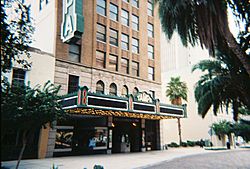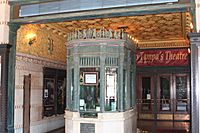Tampa Theatre facts for kids

Exterior of venue (c.2006)
|
|
| Full name | Tampa Theatre Building |
|---|---|
| Address | 711 N Franklin St Tampa, FL 33602-4435 |
| Location | Downtown Tampa |
| Owner | City of Tampa |
| Operator | The Arts Council of Hillsborough County |
| Capacity | 1,252 |
| Construction | |
| Broke ground | April 12, 1925 |
| Opened | October 15, 1926 |
| Renovated | 1976-77; 1992; 2009; 2011-12; 2017 |
| Construction cost | $1.2 million ($20 million in 2022 dollars ) |
| Architect | John Eberson |
|
Tampa Theatre
|
|
| Architectural style | Mediterranean Revival |
| NRHP reference No. | 78000945 |
| Added to NRHP | January 3, 1978 |
The Tampa Theatre is a historic U.S. theater and city landmark in Downtown Tampa, Florida. Designed as an atmospheric theatre-style movie palace by architect John Eberson, it opened on October 15, 1926. The theatre features a wide range of independent, foreign, and documentary films. It is Tampa's only non-profit movie palace, and operating costs are supported by its members, donors, and corporate sponsors, as well as by ticket and concessions sales. It has often been used as a backdrop for movies, music videos, and local programming.
History
Tampa Theatre was the first commercial building in Tampa to offer air conditioning. The theatre's interior resembles a romantic Mediterranean courtyard replete with old-world statuary, flowers, and gargoyles. On the ceiling is an artificial nighttime sky with stars on it.
By the 1960s and 70s, many American movie palaces were demolished because the land beneath them became more valuable than the theatre operation.
In 1973, the theatre faced the same fate. But the citizens rallied and committees were formed. City leaders became involved, and soon a deal was reached to have the City rescue the Tampa Theatre by assuming its leases. The Arts Council of Hillsborough County agreed to program and manage the Tampa Theatre with films, concerts, and special events. By the time the Theatre reopened in early 1978, the Tampa Theatre had become something of a national model on how to save an endangered theater.
In 1992, restoration efforts were led by the Tampa Theatre Foundation after the building caught fire in 1991. The theatre presents and hosts over 600 events a year including a full schedule of the first run and classic films, concerts, special events, corporate events, tours, and educational programs.
Since its rescue in 1978, the theatre has welcomed over five million guests including over one million school children for school field trips and summer camps in the context of one of Tampa's largest historic preservation projects.
It was named to the National Register of Historic Places in 1978, is a Tampa City Landmark, and is a member of the League of Historic American Theatres.
The theatre has undergone many restoration projects as well as equipment upgrades. The most recent restoration project was the replacement of the marquee which includes the vertical blade sign and the canopy. The completion was marked by the Marquee Lighting Ceremony which took place on January 16, 2004.
The theatre operates The Mighty Wurlitzer Theatre Organ and the instrument is played before nightly films. The organ is played and maintained by a team of volunteer organists from the Central Florida Theatre Organ Society.
In the spring of 2013, during its 86th year of existence, efforts began to convert to digital picture and sound (with the exception of productions that are only available in the movie reel format) and screened a free showing of Samsara to celebrate the transition. The switch to digital occurred at a cost of $150,000.
In late 2017, the Theatre closed for six weeks to complete the first phase of its long-term restoration plan, a $6 million renovation that updated the electrical systems, re-seated the auditorium with seats designed to match the original look from 1926, added a new and expanded concessions stand and bar, installed a new emergency power system, and protected the building from storms by installing new storm rated windows and doors on the Florida Avenue side of the building. The seating capacity was reduced from 1,446 to 1,238 to improve comfort and legroom. A new carpet, designed to match the original 1926 design, was installed, as well as a new grand drape and valance for the proscenium arch also designed to match the original.
The lobby paint and plaster were restored to their original palette by crews from EverGreene Studios, in New York, including the replication of four tapestries to replace the faded and worn tapestries from 1926. The original tapestries were transferred to the Tampa Bay History Center for preservation.
Noted performers
- Gregg Allman Band
- Tori Amos (3 times)
- Blondie
- Lindsey Buckingham
- David Byrne
- Colbie Caillat
- Ray Charles
- Harry Chapin
- Chris Cornell
- Miranda Cosgrove
- Elvis Costello
- Jamie Cullum
- Ani DiFranco
- Dr. John
- The Dresden Dolls
- Drive-By Truckers
- Steve Earle
- Jimmy Fallon
- Genesis
- Gov't Mule (3 times)
- Arlo Guthrie
- Buddy Guy
- Emmylou Harris
- Iron Butterfly
- Joe Jackson
- Albert King
- B.B. King (9 times)
- Kris Kristofferson
- Ray LaMontagne
- Amos Lee
- John Legend
- Gordon Lightfoot
- Darlene Love
- Love and Rockets
- Shelby Lynne
- Aimee Mann
- Dave Mason
- Matisyahu
- Jessica Lea Mayfield
- Delbert McClinton
- Pat Metheny Group
- Randy Newman
- Nickel Creek
- Night Ranger (3 times)
- New Order
- Old Crow Medicine Show
- The Police
- Iggy Pop
- Postmodern Jukebox
- Psychedelic Furs
- Queensrÿche
- Ramones
- Damien Rice
- Todd Rundgren
- Leon Russell
- Joe Satriani
- Boz Scaggs
- Sister Hazel
- Phoebe Snow
- Spyro Gyra
- Tegan and Sara
- Third Eye Blind
- George Thorogood
- Wilco
- "Weird Al" Yankovic
- Warren Zevon
- Andrew Dice Clay
Gallery







